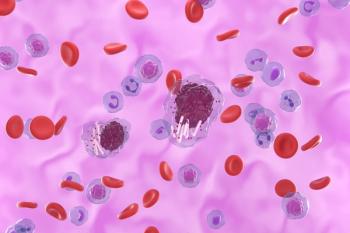
Spleen Stiffness Measurement Linked With Portal Hypertension in MPNs
Key Takeaways
- Spleen stiffness measurement (SSM) offers a noninvasive method to diagnose portal hypertension in BCR::ABL1-negative MPN patients, potentially improving patient management.
- SSM captures hepatic resistance and dynamic portal blood inflow changes, providing independent information about portal hypertension beyond splenomegaly.
A new report suggests a noninvasive means to evaluate portal hypertension in patients with BCR::ABL1-negative myeloproliferative neoplasms.
Spleen stiffness measurements may help improve the diagnosis of portal hypertension in patients with BCR::ABL1-negative myeloproliferative neoplasms (MPNs), a new report suggests.1 The findings,
Co-corresponding author Maria-Theresa Krauth, MD, of the Medical University of Vienna, and colleagues, said splanchnic vein thrombosis (SVT) is a common complication of patients with BCR::ABL1-negative MPNs that can significantly impact morbidity and mortality if left untreated. “Conversely, in patients with non-cirrhotic/non-malignant SVT, BCR::ALB1-negative MPN are the most common etiological factors,” they wrote.
People with BCR::ABL1-negative MPN often present with splenomegaly, but the evaluation of underlying portal hypertension “can be conflicting and is not standardized,” the authors explained.
In patients with chronic liver disease, vibration-controlled transient elastography (VCTE)
“In contrast to liver stiffness measurement (LSM) as an established surrogate of liver fibrosis and associated sinusoidal portal hypertension, SSM offers the unique advantage to not only capture hepatic resistance, but may also capture dynamic (pre-)sinusoidal vasoconstriction and congestion of the portal blood inflow (a potential surrogate of portal hypertension-associated splanchnic hypoperfusion) and portal hypertension-induced splenic fibrosis,” they wrote.
To test their hypothesis, the investigators conducted a retrospective, cross-sectional analysis of 55 consecutive patients with BCR::ABL1-negative MPNs who received care at the Medical University of Vienna. To be included in the study, patients needed to have undergone LSM/SMM between October 2023 and September 2024.
Most of the patients (69%) were female, and polycythemia vera (40%) was the most common MPN among the group, followed by essential thrombocythemia (36.4%), and primary myelofibrosis (20%). Two patients had MPNs not otherwise specified. The mean age in the cohort was 57.9 years, and one-fourth of the patients (26%) had splanchnic vein thrombi, 34.5% had specific signs of portal hypertension, and 52.7% had nonspecific signs of portal hypertension. Another 21.8% had experienced portal hypertension events prior to the start of the trial period.
“Compared to the literature, these numbers are high and underline the need for multidisciplinary management of these patients,” the authors wrote.
SSM correlated with disease severity, and it “adequately” stratified patients with and without portal hypertension, the authors explained. SSM was strongly linked with splenomegaly but also provided independent information about portal hypertension and showed the best discrimination regarding portal hypertension. Still, the authors said an interdisciplinary approach including both hematology and hepatology might be the best path to managing this patient group. They found that sequentially LSM and SSM helped reduce the diagnostic “gray zone.”
“While SSM yielded the best discrimination regarding portal hypertension, the sequential application of already established, easy-to-remember LSM and SSM cut-offs can adequately rule in/rule out portal hypertension in the majority of patients,” they wrote.
The investigators said limitations of their study are its retrospective design and relatively small sample size. They added that while LSM and SSM are “user-friendly,” VCTE might not be available in all settings.
References
1. Balcar L, Degenfeld-Schonburg L, Hopp C, et al. Non-invasive stratification of portal hypertension in patients with BCR::ABL1-negative myeloproliferative neoplasms. Liver Int. 2025;45(6):e70098. doi:10.1111/liv.70098
2. Jachs M, Odriozola A, Turon F, et al. Spleen stiffness measurement by vibration-controlled transient elastography at 100 Hz for non-invasive predicted diagnosis of clinically significant portal hypertension in patients with compensated advanced chronic liver disease: a modelling study. Lancet Gastroenterol Hepatol. 2024;9(12):1111-1120. doi:10.1016/S2468-1253(24)00234-6
Newsletter
Stay ahead of policy, cost, and value—subscribe to AJMC for expert insights at the intersection of clinical care and health economics.









































